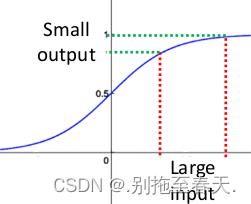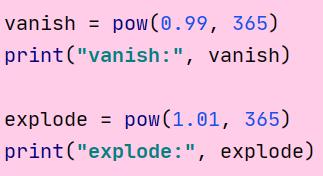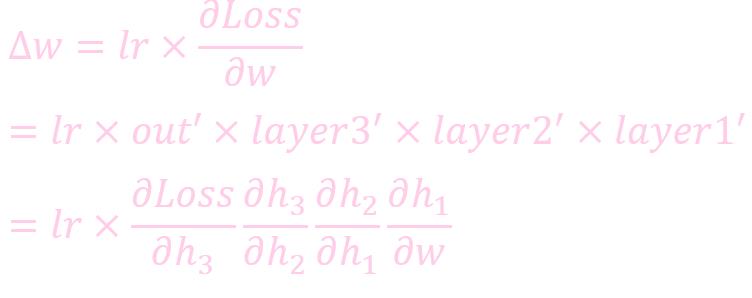剑指offer梯度消失和梯度爆炸
Posted .别拖至春天.
tags:
篇首语:本文由小常识网(cha138.com)小编为大家整理,主要介绍了剑指offer梯度消失和梯度爆炸相关的知识,希望对你有一定的参考价值。
【剑指offer】系列文章目录
文章目录
梯度消失和梯度爆炸
梯度消失和梯度爆炸是深度神经网络中常见的问题,这些问题可能导致模型无法训练或者训练过程非常缓慢。
【文末配有代码,可以参考代码案例进行理解以下概念】
-
梯度消失指的是在反向传播过程中,模型的某些层的梯度非常小,甚至接近于0,导致这些层的参数几乎无法更新。这种情况产生的原因有:一是在深层网络中,当网络层数较多时,梯度会在反向传播过程中多次相乘,使得梯度值逐渐变小,最终消失。当梯度消失时,网络的学习效果会变得非常差,甚至无法训练。二是采用了不合适的损失函数,比如sigmoid。当梯度消失发生时,接近于输出层的隐藏层由于其梯度相对正常,所以权值更新时也就相对正常,但是当越靠近输入层时,由于梯度消失现象,会导致靠近输入层的隐藏层权值更新缓慢或者更新停滞。这就导致在训练时,只等价于后面几层的浅层网络的学习。
-
梯度爆炸指的是在反向传播过程中,模型的某些层的梯度非常大,甚至超过了计算机可以表示的范围,导致这些层的参数发生了非常大的变化。这种情况通常发生在深度神经网络中,当网络层数较多时,梯度会在反向传播过程中多次相乘,使得梯度值逐渐变大,最终爆炸。当梯度爆炸时,网络的学习效果也会变得非常差,甚至无法训练。梯度爆炸会伴随一些细微的信号,如:①模型不稳定,导致更新过程中的损失出现显著变化;②训练过程中,在极端情况下,权重的值变得非常大,以至于溢出,导致模型损失变成 NaN等等。
为什么会产生梯度消失和梯度爆炸
梯度消失:
根据链式法则,如果每一层神经元对上一层的输出的偏导乘上权重结果都小于1的话,那么即使这个结果是0.99,在经过足够多层传播之后,误差对输入层的偏导会趋于0
关于梯度消失,以sigmoid函数为例子,sigmoid函数使得输出在[0,1]之间。

事实上x到了一定大小,经过sigmoid函数的输出范围就很小了,参考下图

如果输入很大,其对应的斜率就很小,我们知道,其斜率(梯度)在反向传播中是权值学习速率。所以就会出现如下的问题:
在深度网络中,如果网络的激活输出很大,其梯度就很小,学习速率就很慢。假设每层学习梯度都小于最大值0.25,网络有n层,因为链式求导的原因,第一层的梯度小于0.25的n次方,所以学习速率就慢,对于最后一层只需对自身求导1次,梯度就大,学习速率就快。
这会造成的影响是在一个很大的深度网络中,浅层基本不学习,权值变化小,后面几层一直在学习,结果就是,后面几层基本可以表示整个网络,失去了深度的意义。
代码示例
代码如下(示例):
import torch
import torch.nn as nn
import numpy as np
# 定义一个五层的全连接神经网络
class Net(nn.Module):
def __init__(self):
super(Net, self).__init__()
self.fc1 = nn.Linear(1, 10)
self.fc2 = nn.Linear(10, 10)
self.fc3 = nn.Linear(10, 10)
self.fc4 = nn.Linear(10, 10)
self.fc5 = nn.Linear(10, 1)
def forward(self, x):
x = torch.relu(self.fc1(x))
x = torch.relu(self.fc2(x))
x = torch.relu(self.fc3(x))
x = torch.relu(self.fc4(x))
x = self.fc5(x)
return x
# 定义一个计算权重梯度的函数
def compute_gradient(net, x):
y = net(x)
loss = torch.sum(y)
loss.backward()
gradients = [p.grad for p in net.parameters()]
return gradients
# 定义一个计算梯度变化的函数
def compute_gradient_change(gradients1, gradients2):
gradient_change = []
for g1, g2 in zip(gradients1, gradients2):
if g1 is None or g2 is None:
gradient_change.append(None)
else:
gradient_change.append(torch.norm(g1 - g2) / torch.norm(g1))
return gradient_change
# 定义一个计算梯度的函数
def compute_gradient_norm(gradients):
gradient_norm = [torch.norm(g) for g in gradients if g is not None]
return gradient_norm
# 定义一个训练函数
def train(net, optimizer, x, num_epochs=1000):
for epoch in range(num_epochs):
optimizer.zero_grad()
y = net(x)
loss = torch.sum(y)
loss.backward()
optimizer.step()
# 构造输入数据
x = torch.linspace(-1, 1, 100).reshape(-1, 1)
# 计算梯度变化
net1 = Net()
net2 = Net()
gradients1 = compute_gradient(net1, x)
optimizer1 = torch.optim.SGD(net1.parameters(), lr=0.1)
train(net1, optimizer1, x, num_epochs=100)
gradients2 = compute_gradient(net1, x)
# 计算梯度变化
gradient_change1 = compute_gradient_change(gradients1, gradients2)
# 计算梯度范数
gradient_norm1 = compute_gradient_norm(gradients2)
# 修改激活函数为sigmoid
class NetSigmoid(nn.Module):
def __init__(self):
super(NetSigmoid, self).__init__()
self.fc1 = nn.Linear(1, 10)
self.fc2 = nn.Linear(10, 10)
self.fc3 = nn.Linear(10, 10)
self.fc4 = nn.Linear(10, 10)
self.fc5 = nn.Linear(10, 1)
def forward(self, x):
x = torch.sigmoid(self.fc1(x))
x = torch.sigmoid(self.fc2(x))
x = torch.sigmoid(self.fc3(x))
x = torch.sigmoid(self.fc4(x))
x = self.fc5(x)
return x
# 计算梯度变化
net3 = NetSigmoid()
gradients1 = compute_gradient(net3, x)
optimizer3 = torch.optim.SGD(net3.parameters(), lr=0.1)
train(net3, optimizer3, x, num_epochs=100)
gradients2 = compute_gradient(net3, x)
gradient_change2 = compute_gradient_change(gradients1, gradients2)
# 计算梯度范数
gradient_norm2 = compute_gradient_norm(gradients2)
print('Gradient change (ReLU):', gradient_change1)
print('Gradient norm (ReLU):', gradient_norm1)
print('Gradient change (sigmoid):', gradient_change2)
print('Gradient norm (sigmoid):', gradient_norm2)
输出结果:
Gradient change (ReLU): [tensor(nan), tensor(nan), tensor(nan), tensor(nan), tensor(nan), tensor(nan), tensor(nan), tensor(nan), tensor(nan), tensor(0.)]
Gradient norm (ReLU): [tensor(nan), tensor(nan), tensor(nan), tensor(nan), tensor(nan), tensor(nan), tensor(nan), tensor(nan), tensor(nan), tensor(200.)]
Gradient change (sigmoid): [tensor(0.), tensor(0.), tensor(0.), tensor(0.), tensor(0.), tensor(0.), tensor(0.), tensor(0.), tensor(0.), tensor(0.)]
Gradient norm (sigmoid): [tensor(6.4147e-05), tensor(0.0017), tensor(0.0174), tensor(0.0106), tensor(0.0838), tensor(0.0480), tensor(0.1575), tensor(0.0573), tensor(632.4555), tensor(200.)]
前两行输出是梯度爆炸的效果,后两行是梯度消失的效果,具体含义可结合代码了解
使用sigmoid。当梯度消失发生时,接近于输出层的隐藏层由于其梯度相对正常,所以权值更新时也就相对正常,但是当越靠近输入层时,由于梯度消失现象,会导致靠近输入层的隐藏层权值更新缓慢或者更新停滞。这就导致在训练时,只等价于后面几层的浅层网络的学习。
TensorFlow2 手把手教你避开梯度消失和梯度爆炸
TensorFlow2 手把手教你避开梯度消失和梯度爆炸
梯度消失 & 梯度爆炸

输出结果:
vanish: 0.025517964452291125
explode: 37.78343433288728
梯度消失
梯度消失问题 (Vanishing gradient problem). 如果导数小于 1, 随着网络层数的增加梯度跟新会朝着指数衰减的方向前进, 这就是梯度消失.

当导数小于 1 的时候, 层数越多, 梯度就越小, 即梯度消失.
梯度爆炸
梯度爆炸问题 (Exploding gradient problem). 如果导数大于 1, 随着网络层数的增加梯度跟新会朝着指数增加的方向前进, 这就是梯度爆炸.

当导数大于 1 的时候, 层数越多, 梯度就越大, 即梯度爆炸.
张量限幅
通过张量限幅, 我们可以有效解决梯度爆炸问题.

tf.clip_by_value
我们可以通过tf.clip_by_value函数来实现张量限幅.
格式:
tf.clip_by_value(
t, clip_value_min, clip_value_max, name=None
)
参数:
- t: 传入的张量
- clip_value_min: 下限
- clip_value_max: 上限
- name: 数据名称
例子:
# clip_by_value
a = tf.range(10)
print(a)
b = tf.maximum(a, 2)
print(b)
c = tf.minimum(a, 8)
print(c)
d = tf.clip_by_value(a, 2, 8)
print(d)
输出结果:
tf.Tensor([0 1 2 3 4 5 6 7 8 9], shape=(10,), dtype=int32)
tf.Tensor([2 2 2 3 4 5 6 7 8 9], shape=(10,), dtype=int32)
tf.Tensor([0 1 2 3 4 5 6 7 8 8], shape=(10,), dtype=int32)
tf.Tensor([2 2 2 3 4 5 6 7 8 8], shape=(10,), dtype=int32)
tf.clip_by_norm
tf.clip_by_norm可以对梯度进行裁剪, 防止梯度爆炸.
格式:
tf.clip_by_norm(
t, clip_norm, axes=None, name=None
)
参数:
- t: 传入的张量
- clip_norm: 定义最大限幅
- axes: 计算尺寸
- name: 数据名称
例子:
# clip_by_normal
a = tf.random.normal([2, 2], mean=10)
print(a)
print(tf.norm(a)) # 范数
b = tf.clip_by_norm(a, 15)
print(b)
print(tf.norm(b)) # 范数
输出结果:
tf.Tensor(
[[ 9.33037 10.703022]
[ 9.788097 9.713704]], shape=(2, 2), dtype=float32)
tf.Tensor(19.793266, shape=(), dtype=float32)
tf.Tensor(
[[7.070867 8.111109 ]
[7.417748 7.3613706]], shape=(2, 2), dtype=float32)
tf.Tensor(15.0, shape=(), dtype=float32)
mnist 展示梯度爆炸
为了实现梯度爆炸, 我们把学习率设为 0.1.
完整代码
# 读取训练集的特征值和目标值
(x, y), _ = tf.keras.datasets.mnist.load_data()
# 转换为0~1的形式
x = tf.convert_to_tensor(x, dtype=tf.float32) / 255
# 转换成one_hot编码
y = tf.one_hot(y, depth=10)
# 批次分割
train_db = tf.data.Dataset.from_tensor_slices((x, y)).batch(256).repeat(30)
def main():
# 生成w1形状为[784, 512]的截断正态分布, 中心为0, 标差为0.1
w1 = tf.Variable(tf.random.truncated_normal([784, 512], stddev=0.1))
# 生成b1形状为[512]初始化为0
b1 = tf.Variable(tf.zeros([512]))
# 生成w2形状为[512, 256]的截断正态分布, 中心为0, 标差为0.1
w2 = tf.Variable(tf.random.truncated_normal([512, 256], stddev=0.1))
# 生成b2形状为[256]初始化为0
b2 = tf.Variable(tf.zeros([256]))
# 生成w3形状为[256, 10]的截断正态分布, 中心为0, 标差为0.1
w3 = tf.Variable(tf.random.truncated_normal([256, 10], stddev=0.1))
# 生成b3形状为[10]初始化为0
b3 = tf.Variable(tf.zeros([10]))
# 优化器
optimizer = tf.keras.optimizers.SGD(learning_rate=0.1) # 梯度下降
for step, (x, y) in enumerate(train_db):
# 把x平铺 [256, 28, 28] => [256, 784]
x = tf.reshape(x, [-1, 784])
with tf.GradientTape() as tape:
# 第一个隐层
h1 = x @ w1 + b1
h1 = tf.nn.relu(h1) # 激活
# 第二个隐层
h2 = h1 @ w2 + b2
h2 = tf.nn.relu(h2) # 激活
# 输出层
out = h2 @ w3 + b3
# 计算损失函数
loss = tf.square(y - out)
loss = tf.reduce_mean(loss)
# 计算梯度
grads = tape.gradient(loss, [w1, b1, w2, b2, w3, b3])
# 调试输出剪切前的范数
print("================before===============")
for g in grads:
print(tf.norm(g))
grads, _ = tf.clip_by_global_norm(grads, 15)
# 调试输出剪切后的范数
print("================after===============")
for g in grads:
print(tf.norm(g))
optimizer.apply_gradients(zip(grads, [w1, b1, w2, b2, w3, b3])) # 跟新权重
if __name__ == '__main__':
main()
输出结果
================before===============
tf.Tensor(5.5961547, shape=(), dtype=float32)
tf.Tensor(0.87258744, shape=(), dtype=float32)
tf.Tensor(7.397964, shape=(), dtype=float32)
tf.Tensor(0.69156337, shape=(), dtype=float32)
tf.Tensor(9.840232, shape=(), dtype=float32)
tf.Tensor(0.8157242, shape=(), dtype=float32)
================after===============
tf.Tensor(5.5961547, shape=(), dtype=float32)
tf.Tensor(0.87258744, shape=(), dtype=float32)
tf.Tensor(7.397964, shape=(), dtype=float32)
tf.Tensor(0.69156337, shape=(), dtype=float32)
tf.Tensor(9.840232, shape=(), dtype=float32)
tf.Tensor(0.8157242, shape=(), dtype=float32)
================before===============
tf.Tensor(18.01539, shape=(), dtype=float32)
tf.Tensor(2.9375393, shape=(), dtype=float32)
tf.Tensor(21.330334, shape=(), dtype=float32)
tf.Tensor(2.1504176, shape=(), dtype=float32)
tf.Tensor(21.820374, shape=(), dtype=float32)
tf.Tensor(2.0918982, shape=(), dtype=float32)
================after===============
tf.Tensor(7.5730414, shape=(), dtype=float32)
tf.Tensor(1.2348388, shape=(), dtype=float32)
tf.Tensor(8.966527, shape=(), dtype=float32)
tf.Tensor(0.90396047, shape=(), dtype=float32)
tf.Tensor(9.172523, shape=(), dtype=float32)
tf.Tensor(0.8793609, shape=(), dtype=float32)
================before===============
tf.Tensor(0.5821787, shape=(), dtype=float32)
tf.Tensor(0.0859229, shape=(), dtype=float32)
tf.Tensor(0.7110027, shape=(), dtype=float32)
tf.Tensor(0.082481824, shape=(), dtype=float32)
tf.Tensor(0.51846975, shape=(), dtype=float32)
tf.Tensor(0.1655324, shape=(), dtype=float32)
================after===============
tf.Tensor(0.5821787, shape=(), dtype=float32)
tf.Tensor(0.0859229, shape=(), dtype=float32)
tf.Tensor(0.7110027, shape=(), dtype=float32)
tf.Tensor(0.082481824, shape=(), dtype=float32)
tf.Tensor(0.51846975, shape=(), dtype=float32)
tf.Tensor(0.1655324, shape=(), dtype=float32)
... ...
以上是关于剑指offer梯度消失和梯度爆炸的主要内容,如果未能解决你的问题,请参考以下文章